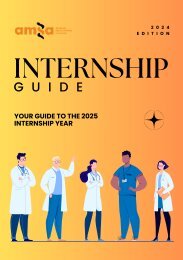AJGH Nexus - Volume 17 2023
AMSA Journal of Global Health (AJGH) 2023 Issue "Nexus"
AMSA Journal of Global Health (AJGH) 2023 Issue "Nexus"
You also want an ePaper? Increase the reach of your titles
YUMPU automatically turns print PDFs into web optimized ePapers that Google loves.
<strong>Volume</strong> <strong>17</strong> | <strong>2023</strong><br />
health campaigns that are cognisant of peoples’<br />
individual concerns are more likely to have<br />
better adherence and may allay excessive or<br />
unhelpful levels of worry by helping people play<br />
an active role in preventing what worries them.<br />
[9] We define worry in this case to be similar to<br />
fear of the unknown, in this case, a virus. This<br />
approach is in contrast to “fearmongering”<br />
which increases worry but tends to reduce<br />
compliance as people are overcome by distress.<br />
[9]<br />
Addressing unnecessary concerns is also an area<br />
of interest due to the globally recognised impact<br />
of the pandemic on mental health and levels of<br />
psychological distress.[10] This is because public<br />
health restrictions may interfere with social<br />
determinants of mental health, including<br />
employment, financial security, ability to engage<br />
in leisure activities and social isolation.[10] In<br />
this study we hypothesised that people with<br />
psychological distress are more likely than those<br />
without to be worried about COVID-19.<br />
Understanding patterns of worry and predictors<br />
could therefore help target interventions to<br />
groups at higher risk of poor mental health and<br />
symptomatic psychological distress in the<br />
pandemic.<br />
pre-existing social contacts enabling a<br />
convenience sample of personal and<br />
professional networks and subsequent<br />
snowballing. The survey was only made available<br />
in English language and Australian residence<br />
was part of the inclusion criteria. The other<br />
inclusion criteria were being 18 years or older<br />
and having engaged in voluntary or paid work at<br />
any time during the period from December 2019<br />
to July 2020.<br />
2.4 Ethics approval and consent<br />
This study was conducted in compliance with the<br />
Declaration of Helsinki, the National Statement<br />
on Ethical Conduct in Human Research (2007,<br />
updated 2018) and ethics approval was granted<br />
by the Office of Research Ethic and Integrity at<br />
The University of Melbourne (approval number:<br />
2056921.1). All participants provided electronic<br />
informed consent before completing the survey.<br />
2.5 Measures<br />
Worry about COVID-19 was measured using a<br />
COVID-19 Worry Scale consisting of 15 questions<br />
(Appendix A).[15] Participants were asked to<br />
indicate their level of worry about each question<br />
on a scale of 1-9 with 1 being “Don’t worry at all”<br />
and 9 being “Worry a lot”.<br />
2. Methods<br />
2.1 Study design<br />
This study retrospectively analysed data<br />
obtained from a cross-sectional online survey<br />
titled “COVID-19 and Mental Health”.<br />
2.2 Context<br />
The survey took place between 29th May and 8th<br />
July 2020, close to the beginning of Victoria’s<br />
second wave of COVID-19. At the time of the<br />
survey, most of the restrictions from earlier in<br />
2020 had eased nation-wide but were gradually<br />
reintroduced in Victoria from June 20th.[12] This<br />
study was part of a larger program of research<br />
looking at how people have responded to the<br />
pandemic in Australia. Further details can be<br />
found here.[13, 14]<br />
2.3 Recruitment<br />
A link to the survey was distributed via email to<br />
The survey collected demographic information<br />
on participants including age, sex, living<br />
situation, employment status and industry of<br />
primary paid or volunteer work (Table 1). For the<br />
latter, 18 options were presented according to<br />
categories recognised by the Australian Bureau<br />
of Statistics (ABS) as well as the option for<br />
manual entry. In addition, participants were<br />
asked about any previously diagnosed chronic<br />
physical or mental health conditions and if they<br />
had previously been diagnosed with COVID-19.<br />
The 21-item Depression Anxiety and Stress Scale<br />
(DASS21) questionnaire was also included as part<br />
of the survey and used to measure self-reported<br />
symptoms of depression (low mood), anxiety<br />
(somatic symptoms, panic and fear) and stress<br />
(tension, intolerance and overreaction to<br />
situations).[16,<strong>17</strong>] The DASS21 was used to<br />
evaluate our hypothesis that greater levels of<br />
worry about COVID-19 correlates with higher<br />
levels of psychological distress.

















